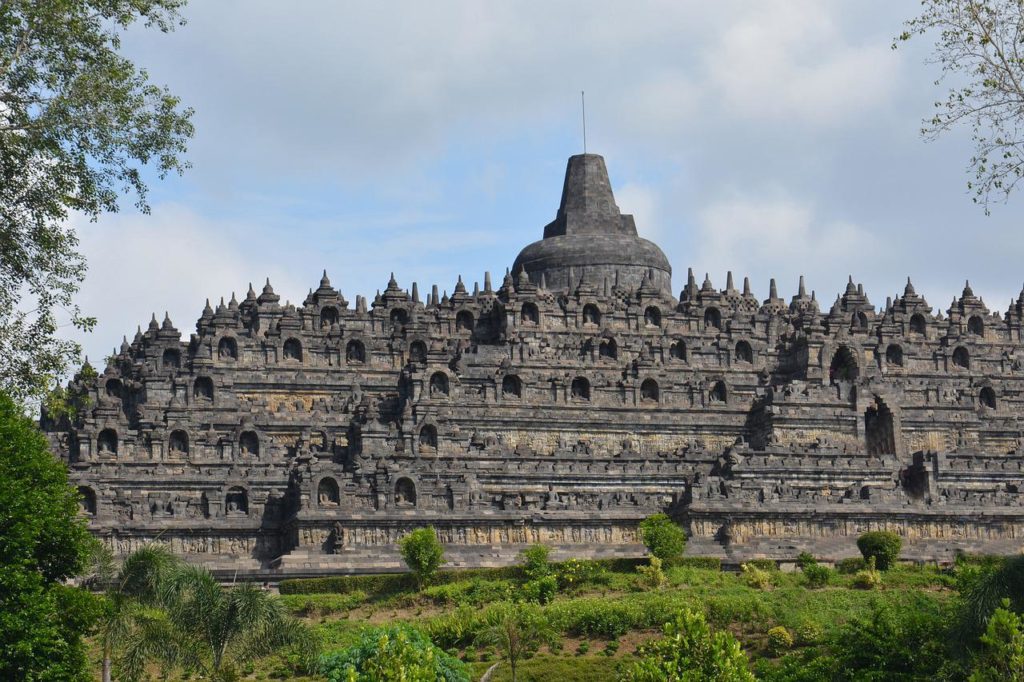Though often overshadowed by Jakarta, this cradle of Javanese civilisation is the gateway to two ancient temples – Borobudur and Prambanan – and is not to be missed for those who seek to discover the country’s past and Yogyakarta’s unique heritage.
Enter the court of the ruler
Built in the 18th century by the first Sultan of Yogyakarta, Keraton Ngayogyakarta Hadiningrat is an enduring testament to the glory of the ruling Hamengkubuwono family.
A sprawling complex that serves as the sultan’s residence, the keraton or royal palace is open to the public at designated times daily, allowing visitors a rare peek at this fascinating form of Javanese architecture.
 The large, stunning wooden structures and pavilions dotting the palace’s seven zones were built in the old joglo style, and are adorned with natural motifs inspired by local flora and fauna.
The large, stunning wooden structures and pavilions dotting the palace’s seven zones were built in the old joglo style, and are adorned with natural motifs inspired by local flora and fauna.
Another highlight is Bangsal Kencana, the main reception hall used to welcome foreign dignitaries. With its carved teak columns and marble flooring, it leaves an imposing first impression.
Explore a royal complex
For those with a more cultural bent, the treasure trove of exhibits at the Sonobudoyo Museum might pique your interest.
Opened in 1935, the museum hosts a notable collection of over 42,000 Javanese artefacts, including traditional artworks, pottery, musical instruments, shadow puppets and weaponry.

Its facade is a symbol of heritage, designed to resemble the island’s oldest palace, the Keraton Kasepuhan in West Java’s Cirebon city.
The museum’s central location, just a stone’s throw from Keraton Ngayogyakarta Hadiningrat, makes it easily accessible and allows visitors to the palace to complete their cultural circuit here.
Get up close with Javanese culture
For those with a more cultural bent, the treasure trove of exhibits at the Sonobudoyo Museum might pique your interest.
Opened in 1935, the museum hosts a notable collection of over 42,000 Javanese artefacts, including traditional artworks, pottery, musical instruments, shadow puppets and weaponry.
 Its facade is a symbol of heritage, designed to resemble the island’s oldest palace, the Keraton Kasepuhan in West Java’s Cirebon city.
Its facade is a symbol of heritage, designed to resemble the island’s oldest palace, the Keraton Kasepuhan in West Java’s Cirebon city.
The museum’s central location, just a stone’s throw from Keraton Ngayogyakarta Hadiningrat, makes it easily accessible and allows visitors to the palace to complete their cultural circuit here.
Hike up a dormant volcano
Situated in Yogyakarta’s Gunung Kidul regency, Mount Nglanggeran is a dormant supervolcano-turned-national park where visitors can enjoy an easy to medium hike to the top.

Just a 90-minute journey to its 700-metre high summit and you’ll be welcomed by spellbinding vistas of the majestic mountain range and, on a good day, Mount Merapi.
When you make your descent, make time to stop at Embung Nglanggeran, an artificial lake where you can unwind and catch the sunrise before continuing your climb down.
A popular draw in the area is the Nglanggeran Village, an eco-tourism sanctuary where you can take a refreshing dip in the Kedung Kandang waterfall or simply enjoy the view from a bamboo bridge at the falls.
Discover the ancient temple ruins
The 9th century temples of Borobudur and Prambanan hold the distinction of being among the very first places in Indonesia inscribed as a UNESCO World Heritage site back in 1991.
Dedicated to the Hindu supreme trinity of Brahma, Vishnu and Shiva, Prambanan – located 45 minutes by car from Yogyakarta – is a monumental display of vastu shastra or classical Indian architecture.
 It’s also worth travelling 90-minutes northwest of Yogyakarta to Borobudur, the world’s largest Buddhist temple, famed for its iconic stone stupas and mandala-inspired plan.
It’s also worth travelling 90-minutes northwest of Yogyakarta to Borobudur, the world’s largest Buddhist temple, famed for its iconic stone stupas and mandala-inspired plan.
Both these sites are important places of pilgrimage for their respective faiths, with their proximity an example of the long history of religious tolerance in Indonesia.
According to airaisia.com














